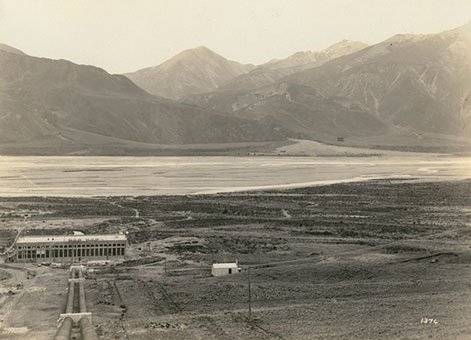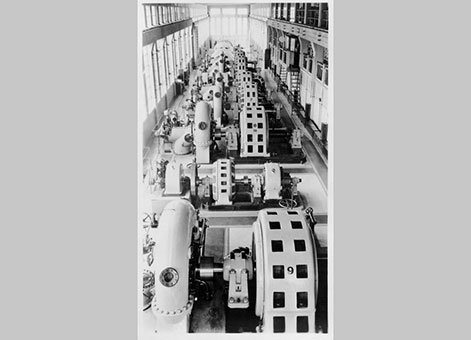The New Zealand government's first major involvement in electric power supply was at Lake Coleridge on the Rakaia River. It provided Christchurch’s total power needs in the early 20th century.
Construction began in 1911 following the 1910 Aid to Waterpower Act which gave the government authority to borrow money for hydro-electric development. The station, with its three 1,500 kilowatt (kW) generators (six were planned), was opened on 15 November 1914 by Prime Minister William Massey. Regular supply was given to Christchurch in March 1915.
The construction of the powerhouse was a remarkable feat for that time, in that it had to be built on loose shingle of the Rakaia River and this led to many troubles for the New Zealand engineers to master. However, this experience benefited subsequent stations, such as Waitaki and Highbank, and contributed to world knowledge on how to construct big hydro plants on loose shingle.
Also of significance was the construction of two 66 kilovolt, 100 kilometre (km) transmission lines to Christchurch, which were the highest voltage and longest length in New Zealand at the time. This work was started in 1913 and was completed in November 1914.

Photograph of a scene at Lake Coleridge, Canterbury, including the hyroelectric power station [circa 1920s]. Ref: PAColl-9380. Alexander Turnbull Library, Wellington, New Zealand.
The progressive development of the scheme owing to post-World War One demand led to further generators, a second intake, surge chamber, tunnel and pipelines and the final commissioning in 1930 with total output increased to 34,500 kW.
To meet the potential of the scheme, it was necessary to obtain further water, which came first from the Harper River, later from a diversion of water from the Acheron Stream and finally from the Wilberforce River.
Through the sale promotion of Lake Coleridge power, most of the boroughs and counties near Christchurch were induced to become electricity supply authorities. The making of numerous contracts with relatively small-scale consumers or groups became unwieldy and led to the Government passing the Electric Power Boards Act 1918, which was later consolidated as the 1925 Act, setting the ground work for the orderly distribution of electric power in New Zealand.
Commemorative features
There are some marble plaques located in the entrance to the building which document important centenaries and people in the history of electricity.
One, dating from 1919, marks the centenary of Hans Christian Oersted's (Danish physicist and chemist) discovery of the magnetic effect of an electrical current.
The other plaque commemorates English physicist Michael Faraday's 1831 development of the method for creating electric current through moving magnets. The Faraday Society in the United Kingdom advises that, as far as they are aware, the Faraday Centenary Memorial tablet is the only one in the world in a power station (Bruce Comfort, pers com 2009).

Harte, R (Mr), fl 1989. Generator room, hydroelectric Station, Lake Coleridge [April 1932]. Ref: 1/2-112295-F. Alexander Turnbull Library, Wellington, New Zealand.
Heritage recognition
IPENZ “Engineering to 1990” project
This item of New Zealand’s engineering heritage was recognised as part of the IPENZ “Engineering to 1990” project, which the Institution organised to help celebrate the country’s sesquicentenary in 1990. A plaque was unveiled to mark the significance of this power station as part of the development of the nation.
More information
Access
Public access is restricted. External views of the facilities can be seen from Hummocks Road.
Reference
Rosemary Britten, Lake Coleridge: The power, the people, the land, Christchurch, 2000.
Additional image gallery details
Photograph of a scene at Lake Coleridge, Canterbury, including the hyroelectric power station [circa 1920s]. Ref: PAColl-9380. Alexander Turnbull Library, Wellington, New Zealand.
Harte, R (Mr), fl 1989. Generator room, hydroelectric Station, Lake Coleridge [April 1932]. Ref: 1/2-112295-F. Alexander Turnbull Library, Wellington, New Zealand.
Permission of the Alexander Turnbull Library, Wellington, New Zealand, must be obtained before any re-use of these images.
Location
Lake Coleridge, 100 kilometres from Christchurch, Upper Rakaia River.
